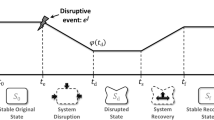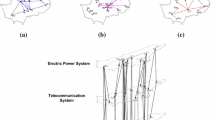Abstract
Urban systems are characterized by very complex interactions. After an earthquake, a wide variety of services, networks and urban facilities may be unavailable to the public during the system failure and recovery processes, thereby causing disruptions in the basic social needs of the affected area. After a disaster, communities face several challenges. For example, the lack of education may impose population migrations, or malfunctions in the electricity distribution system can produce electrical power outages of varying duration with respect to time and space, which generates consequences in the water distribution system, transportation, communications, etc. A methodology called the Disruption index (DI), based on graph theory, includes these multiple interdependencies. It has been developed to estimate the dysfunction of some fundamental dimensions of urban systems on a broad level, starting with the physical damages directly suffered by the exposed assets, proceeding to the impacts that each node has on the functional performance of the nodes depending on them, until reaching the top node. This paper presents the fundamental theory to support the DI concept. The DI provides the likely impacts and consequences of an earthquake in an urban area to fulfill hazard mitigation and provide civil protection agencies and local and state governments with a new decision-making instrument to reduce or prevent severe and recurrent impacts. The DI concept can also be extended to other natural and man-made disasters and may be used as a tool for optimizing the resources of the system components.







Similar content being viewed by others
Notes
The authors also mention dimensions like “criteria”, “objectives” or “concerns”.
A topological order of a directed graph [G] is an ordering of its vertices as \(\hbox {v}_{1}\), \(\hbox {v}_{2}\), ..., \(\hbox {v}_\mathrm{n}\) such that, for every edge e(\(\hbox {v}_\mathrm{i}\), \(\hbox {v}_\mathrm{j})\) starting at vertex \(\hbox {v}_\mathrm{i}\) and ending at vertex \(\hbox {v}_\mathrm{j}\), we have i \(<\)j.
“System 1 operates automatically and quickly, with little or no effort and no sense of voluntary control. System 2 allocates attention to the effortful mental activities that demand it, including complex computations (...)”.
References
Andrews JD, Beeson S (2003) Birnbaum’s measure of component importance for noncoherent systems. IEEE Trans Reliab 52(2):213–219
Apostolakis GE, Lemon DM (2005) A screening methodology for the identification and ranking of infrastructure vulnerabilities due to terrorism. Risk Anal 25(2):361–376
Bana e Costa CA, Beinat E (2005) Model-structuring in public decision-aiding. LSEOR 05(79)
Bilham R (2009) The seismic future of cities. Bull Earthq Eng 7:839–887
Cardona O (2005) System of indicators for disaster risk management: Instituto de Estudios Ambientales. Universidad Nacional de Colombia, Manizales
Carreño ML, Cardona OD, Barbat AH (2007) Urban seismic risk evaluation: a holistic approach. Nat Hazards 40(1):137–172
Carreño ML, Cardona OD, Barbat AH (2012) New methodology for urban seismic risk assessment from a holistic perspective. Bull Earthq Eng 10:547–565. doi:10.107/s10518-011-9302-2
Costa A, Ferreira MA, Oliveira CS (2010) O grande sismo de Sichuan: impactos e lições para o futuro. In: Proceedings Sísmica 2010–8\(^{o}\) Congresso Nacional de Engenharia Sísmica. Aveiro, Portugal (in portuguese)
Davidson RA, Shah HC (1997) An urban earthquake disaster risk index. Stanford University, Stanford, CA
Dueñas-Osorio L, Graig JI, Goodno BJ (2007) Seismic response of critical interdependent networks. Earthq Eng Struct Dyn 36:285–306
Ferreira MA (2011) Field mission to Lorca, Spain (personal communication)
Ferreira, MA (2012) Risco sísmico em sistemas urbanos. Ph.D. Thesis. Instituto Superior Técnico, Universidade Técnica de Lisboa. 295 pp (in portuguese)
Kahneman D (2012) Thinking fast and slow. Penguin
Keeney R, Raiffa H (1976) Decisions with multiple objectives: preferences and value tradeoffs. Willey, New York
Kunreuther H, Novemsky N, Kahneman D (2001) Making low probabilities useful. Risk Uncertain 23(2):103–120
Masure P, Lutoff C (2008) Urban system exposure to natural disasters: an integrated approach. In: Oliveira CS, Roca A, Goula X (eds) Assessing and managing earthquake risk. Springer, Berlin, pp 239–260
Michaud D, Apostolakis GE (2006) A methodology for ranking the elements of water-supply networks. J Infrastruct Syst 12(4):230–242
Mota de Sá F, Ferreira MA, Oliveira CS (2013) Disruption index, DI: a tool for prioritizing (optimizing) mitigating policies (in preparation)
Oliveira CS, Ferreira MA (2010) The fragile state of education in Haiti. CELE Exchange. J OECD Centre for Effective Learning Environments. November http://www.oecd.org/document/43/0,3343,en_2649_35961311_46152683_1_1_1_1,00.html
Oliveira CS, Ferreira MA (2012) The concept of a disruption index: application to the overall impact of the July 9, 1998 Faial earthquake (Azores islands). Bull Earthq Eng 10:7–25. doi:10.1007/s10518-011-9333-8
Patterson SA, Apostolakis GE (2005) Identification of critical locations across multiple infrastructures for terrorist actions. Integrated Approaches to Failure in Complex Networks, University of Glasgow, Paper presented at the Safeguarding National Infrastructures
Perrow C (1999) Normal accidents: living with high-risk technologies. Princeton University Press, New Jersey
Phillips LD (2006) Decision conferencing: operational research group. Department of Management, London School of Economics and Political Science
Proença JM, Ferreira MA (2009) L’Aquila, Italy, earthquake hit educational buildings. CELE Exchange. J OECD Centre for Effective Learning Environments. October http://www.oecd.org/document/30/0,3343,en_2649_35961311_43726110_1_1_1_1,00.html
Roy B (1985) Méthodologie multicritère d’aide à la décision. Paris, Economica
Scawthorn C (2011) Disaster casualties—accounting for economic impacts and diurnal variation. In: Spence R, So E, Scawthorn C (eds) Human casualties in earthquakes. Progress in modelling and mitigation, vol 29. Springer, Berlin, pp 322
UPStrat-MAFA (2012) Urban disaster prevention strategies using macroseismic fields and fault sources (UPStrat-MAFA-EU Project Num. 230301/2011/613486/SUB/A5), DG ECHO Unit A5
Ventura CE, García HJ, Martí JM (2010) Understanding interdependencies among critical infrastructures. Paper presented at the 9th U.S. National and 10th Canadian Conference on Earthquake Engineering, Toronto, Ontario, Canada
Zio E, Podofillini L (2003) Importance measures of multi-state components in multi-state systems. Int J Reliab Safety Eng 10(3):289–310
Acknowledgments
The preparation of this paper was supported in part by FCT PhD grants SFRH/BD/29980/2006 (Mónica Amaral Ferreira) and SFRH/BD/71198/2010 (Francisco Mota de Sá) and was co-financed by the EU—Civil Protection Financial Instrument in the framework of the European Project ”Urban disaster Prevention Strategies using MAcroseismic Fields and FAult Sources” (UPStrat-MAFA-Num. 230301/2011/613486/SUB/A5), DG ECHO Unit A5. Special acknowledge to Dr. Gaetano Zonno from INGV, Italy, for all his support and to Prof. Ragnar Sigbjörnsson from University of Iceland, for all support and important suggestions made. We thank Prof. Sancho Oliveira from ISCTE for revising some computational aspects.
Author information
Authors and Affiliations
Corresponding author
Appendix: Description of levels of criteria
Appendix: Description of levels of criteria









Rights and permissions
About this article
Cite this article
Ferreira, M.A., Mota de Sá, F. & Oliveira, C.S. Disruption index, DI: an approach for assessing seismic risk in urban systems (theoretical aspects). Bull Earthquake Eng 12, 1431–1458 (2014). https://doi.org/10.1007/s10518-013-9578-5
Received:
Accepted:
Published:
Issue Date:
DOI: https://doi.org/10.1007/s10518-013-9578-5




